Target Identification with Improved 2D-VMD for Carrier-Free UWB Radar
Abstract
1. Introduction
2. Database Construction
2.1. The TDIE Algorithm
2.2. Comparative Experiments
2.3. Ground Targets Modeling
3. Improved 2D-VMD Algorithm
3.1. 2D-VMD Algorithm
- (a)
- Initialize , and .
- (b)
- Update and in the frequency domain according to Equations (20) and (21).
- (c)
- Update , where
- (d)
- Stop iteration when , where satisfies ; otherwise, return to step (b).
3.2. The Improved 2D-VMD Algorithm
4. Deep Convolutional Neural Network
5. Experiments
5.1. Performance Analysis under Different SNRs
5.2. The Influence of Decomposition Layers
5.3. Baselines
6. Conclusions
Author Contributions
Funding
Institutional Review Board Statement
Informed Consent Statement
Data Availability Statement
Acknowledgments
Conflicts of Interest
References
- Porcino, D.; Hirt, W. Ultra-wideband radio technology: Potential and challenges ahead. IEEE Commun. Mag. 2003, 41, 66–74. [Google Scholar] [CrossRef]
- Sachs, J.; Helbig, M.; Herrmann, R.; Kmec, M.; Schilling, K.; Zaikov, E. Remote vital sign detection for rescue, security, and medical care by ultra-wideband pseudo-noise radar. Ad Hoc Netw. 2014, 13, 42–53. [Google Scholar] [CrossRef]
- Vitebskiy, S.; Carin, L.; Ressler, M.A.; Le, F.H. Ultra-wideband, short-pulse ground-penetrating radar: Simulation and measurement. IEEE Trans. Geosci. Remote Sens. 1997, 35, 762–772. [Google Scholar] [CrossRef]
- Jiang, L.B.; Zhou, X.L.; Che, L. Feature Extraction and Reconstruction by Using 2D-VMD Based on Carrier-Free UWB Radar Application in Human Motion Recognition. Sensors 2019, 19, 1962. [Google Scholar] [CrossRef] [PubMed]
- Selver, M.A.; Taygur, M.M.; Seçmen, M.; Zoral, E.Y. Hierarchical Reconstruction and Structural Waveform Analysis for Target Classification. IEEE Trans. Antennas Propag. 2016, 64, 3120–3129. [Google Scholar] [CrossRef]
- López-Rodríguez, P.; Escot-Bocanegra, D.; Fernández-Recio, R.; Bravo, I. Non-Cooperative Target Recognition by Means of Singular Value Decomposition Applied to Radar High Resolution Range Profiles. Sensors 2015, 15, 422–439. [Google Scholar] [CrossRef]
- Karabayır, O.; Yücedağ, O.M.; Kartal, M.Z.; Serim, H.A. Convolutional neural networks-based ship target recognition using high resolution range profiles. In Proceedings of the International Radar Symposium (IRS), Prague, Czech Republic, 28–30 June 2017; pp. 1–9. [Google Scholar]
- Zhang, H.H.; Fan, Z.H.; Chen, R.S. Marching-on-in-Degree Solver of Time-Domain Finite Element-Boundary Integral Method for Transient Electromagnetic Analysis. IEEE Trans. Antennas Propag. 2014, 62, 319–326. [Google Scholar] [CrossRef]
- Luo, W.; Zhao, J.; Zhu, M.; Yin, W. Efficient Solution of Time-Domain Surface-Wire Integral Equation for Predicting Electromagnetic Responses of Complex Structures. IEEE Antennas Wirel. Propag. Lett. 2014, 13, 1465–1468. [Google Scholar] [CrossRef]
- Ditkowski, A.; Dridi, K.; Hesthaven, J.S. FDTD method for Maxwells equations in complex geometries. In Proceedings of the 16th Annual Review of Progress in Applied Computational Electromagnetics, Monterey, CA, USA, 20–24 March 2020; pp. 917–923. [Google Scholar]
- Lee, J.F.; Lee, R.; Cangellaris, A. Time-domain finite-element methods. IEEE Trans. Antennas Propag. 1997, 45, 430–442. [Google Scholar]
- Rynne, B.P.; Vechinski, D.A.; Rao, S.M. A stable procedure to calculate the transient scattering by conducting surfaces of arbitrary shape. IEEE Trans. Antennas Propag. 1993, 41, 517–520. [Google Scholar] [CrossRef]
- Shanker, B.; Lu, B.M.; Yuan, J.; Michielssen, E. Time Domain Integral Equation Analysis of Scattering from Composite Bodies via Exact Evaluation of Radiation Fields. IEEE Trans. Antennas Propag. 2019, 57, 1506–1520. [Google Scholar] [CrossRef]
- Zwicke, P.E.; Kiss, I. A New Implementation of the Mellin Transform and its Application to Radar Classification of Ships. IEEE Trans. Pattern Anal. Mach. Intell. 1983, PAMI--5, 191–199. [Google Scholar] [CrossRef]
- Zhang, X.D.; Shi, Y.; Bao, Z. A new feature vector using selected bispectra for signal classification with application in radar target recognition. IEEE Trans. Signal Process. 2001, 49, 1875–1885. [Google Scholar] [CrossRef]
- Du, L.; Liu, H.W.; Bao, Z.; Xing, M.D. Radar HRRP target recognition based on higher order spectra. IEEE Trans. Signal Process. 2005, 53, 2359–2368. [Google Scholar]
- Garzon-Guerrero, J.A.; Ruiz, D.P.; Carrion, M.C. Classification of Geometrical Targets Using Natural Resonances and Principal Components Analysis. IEEE Trans. Antennas Propag. 2013, 61, 4881–4884. [Google Scholar] [CrossRef]
- Chan, S.; Lee, K. Radar Target Recognition by MSD Algorithms on Angular-Diversity RCS. IEEE Antennas Wirel. Propag. Lett. 2013, 12, 937–940. [Google Scholar] [CrossRef]
- Pilipović, S.; Prangoski, B. On the Characterizations of Wave Front Sets in Terms of the Short-Time Fourier Transform. Math. Note 2019, 105, 153–157. [Google Scholar] [CrossRef]
- Li, J.; Zhang, Y.; Qi, R.; Liu, Q.H. Wavelet-Based Higher Order Correlative Stacking for Seismic Data Denoising in the Curvelet Domain. IEEE J. Sel. Top. Appl. Earth Obs. Remote Sens. 2017, 10, 3810–3820. [Google Scholar] [CrossRef]
- Dullaert, W.; Rogier, H.; Camillis, L.D.; Dhaene, T. Improving link quality of UWB communication links by means of PSWF-Basis persuit denoising. In Proceedings of the IEEE-APS Topical Conference on Antennas and Propagation in Wireless Communications, Torino, Italy, 12–16 September 2011; pp. 126–129. [Google Scholar]
- Wu, Z.; Huang, N.E. A study of the characteristics of white noise using the empirical mode decomposition method. IEEE Trans. Antennas Propag. Proc. R. Soc. Lond. A 2004, 460, 1597–1611. [Google Scholar] [CrossRef]
- Huang, N.E.; Shen, Z.; Long, S.R.; Wu, M.C.; Shih, H.H.; Zheng, Q.; Yen, N.C.; Tung, C.C.; Liu, H.H. The empirical mode decomposition and the Hilbert spectrum for nonlinear and non-stationary time series analysis. Proc. R. Soc. A 1998, 454, 903–995. [Google Scholar] [CrossRef]
- Zhao, G.; Liang, Q.; Durrani, T.S. An EMD Based Sense-Through-Foliage Target Detection UWB Radar Sensor Networks. IEEE Access 2018, 6, 29254–29261. [Google Scholar] [CrossRef]
- Dragomiretskiy, K.; Zosso, D. Variational Mode Decomposition. IEEE Trans. Signal Process. 2014, 62, 531–544. [Google Scholar] [CrossRef]
- Dragomiretskiy, K.; Zosso, D. Two-Dimensional Variational Mode Decomposition. International Workshop on Energy Minimization Methods in Computer Vision and Pattern Recognition; Springer: Cham, Switzerland, 2015; pp. 197–208. [Google Scholar]
- Doulamis, N.; Doulamis, A.; Protopapadaiks, E. Deep learning for Computer Vision: A Brief Review. Comput. Intell. Neurosci. 2018, 2018, 1–13. [Google Scholar]
- Protopapadaiks, E.; Voulodimos, A.; Popa, C.A.; Doulamis, A.; Doulamis, N.; Dres, D.; Bimpas, M. Stacked Autoencoders for Outlier Detection in Over-the-Horizon Radar Signals. Comput. Intell. Neurosci. 2017, 2017. [Google Scholar] [CrossRef] [PubMed]
- Vincent, P.; Larochelle, H.; Lajoie, I.; Bengio, Y.; Manzagol, P.A. Stacked Denoising Autoencoders: Learning Useful Representation in a Deep Network with a local Denoising Criterion. J. Mach. Learn. Res. 2010, 11, 3371–3408. [Google Scholar]
- Cun, Y.L.; Boser, B.; Denker, J.S.; Henderson, D.; Howard, R.E.; Hubbard, W.; Jackel, L.D. Handwritten digit recognition with a back-propagation network. Proc. Adv. Neural Inf. Process. Syst. 1990, 394–404. Available online: https://proceedings.neurips.cc/paper/1989/file/53c3bce66e43be4f209556518c2fcb54-Paper.pdf (accessed on 2 April 2021).
- Lundén, J.; Koivunen, V. Deep learning for HRRP-based target recognition in multistatic radar systems. In Proceedings of the IEEE Radar Conference, Philadelphia, PA, USA; 2016; pp. 1–6. [Google Scholar]
- Chuan, D.; Chen, B.; Xu, B. Factorized discriminative conditional variational auto-encoder for radar HRRP target recognition. IEEE Trans. Signal Process. 2019, 158, 176–189. [Google Scholar]
- Bo, F.; Chen, B.; Liu, H.W. Radar HRRP target recognition with deep networks. Pattern Recognit. 2017, 61, 379–393. [Google Scholar]
- Chen, L.; Chen, R. A new radar target recognition method based on complex high resolution range profiles. In Proceedings of the International Conference on Microwave and Millimeter Wave Technology (ICMMT), Shenzhen, China, 5–8 May 2012; pp. 1–4. [Google Scholar]
- Bhatnagar, V.; Shaw, A.K.; Williams, R.W. Improved automatic target recognition using singular value decomposition. In Proceedings of the 1998 IEEE International Conference on Acoustics, Speech and Signal Processing, Seattle, WA, USA, 12–15 May 1998; pp. 2717–2720. [Google Scholar]
- Yuan, Y.Y.; Yang, G.L.; Ming, L. Variational mode decomposition denoising combined the detrended fluctuation analysis. IEEE Trans. Signal Process. 2016, 125, 349–364. [Google Scholar]
- Gao, H.Y.; Ma, L.Y.; Dong, H.L. An improved two-dimensional variational mode decomposition algorithm and its application in oil pipeline image. Syst. Sci. Control Eng. 2020, 8, 297–307. [Google Scholar] [CrossRef]
- Liu, C.H.; Yang, Y.; Chen, Y. Handwritten character recognition based on compressive sensing. J. Comput. Appl. IEEE Trans. Signal Process. 2009, 29, 2080–2082. [Google Scholar] [CrossRef]
- Lu, J.W.; Zhao, Y.W. Dominant singular value decomposition representation for face recognition. Signal Process. 2010, 90, 2087–2093. [Google Scholar] [CrossRef]
- Nunes, J.C.; Bouaoune, Y.; Delechelle, E.; Niang, O.; Bunel, P.H. Image analysis by bidimensional empirical mode decomposition. Image Vis. Comput. 2003, 21, 1019–1026. [Google Scholar] [CrossRef]
- Blagosklonov, O.; Comas, L.; Sabbah, R.; Verdenet, J.; Baud, M.; Cardot, J.C. Using Wavelets for Smoothing and Denoising Gated Blood Pool Images; Computers in Cardiology: Memphis, TN, USA, 2002; pp. 189–192. [Google Scholar]
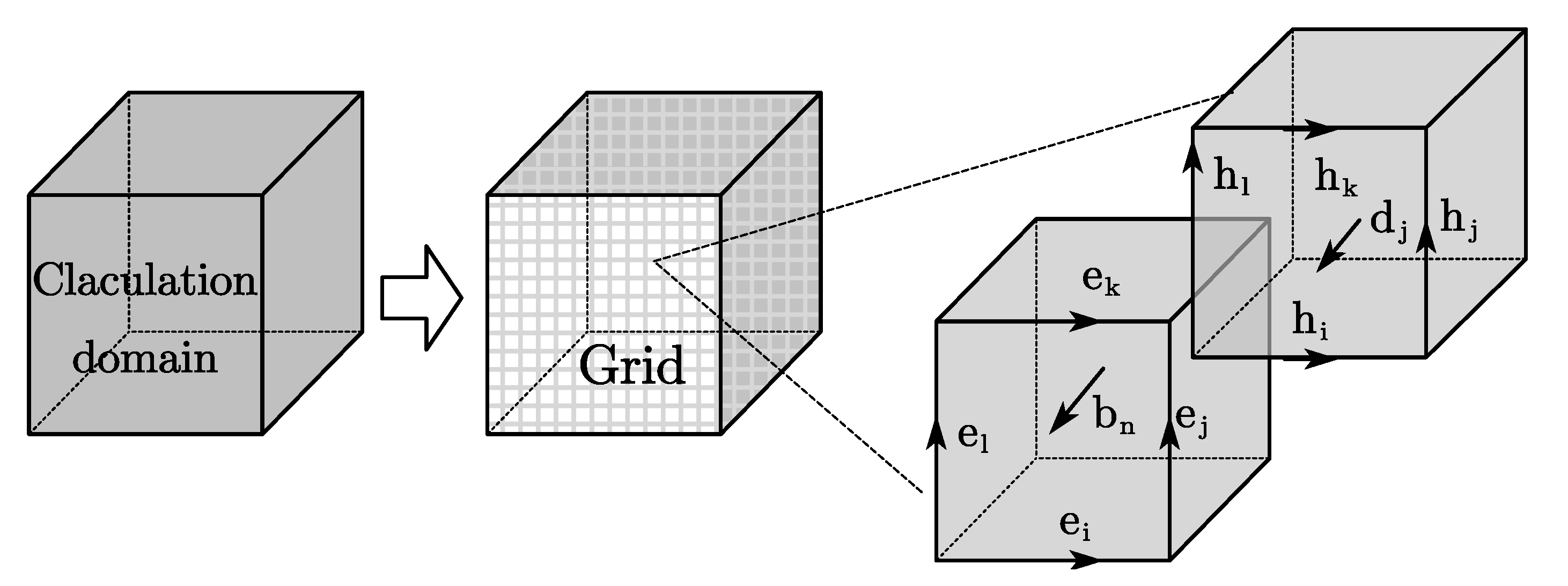
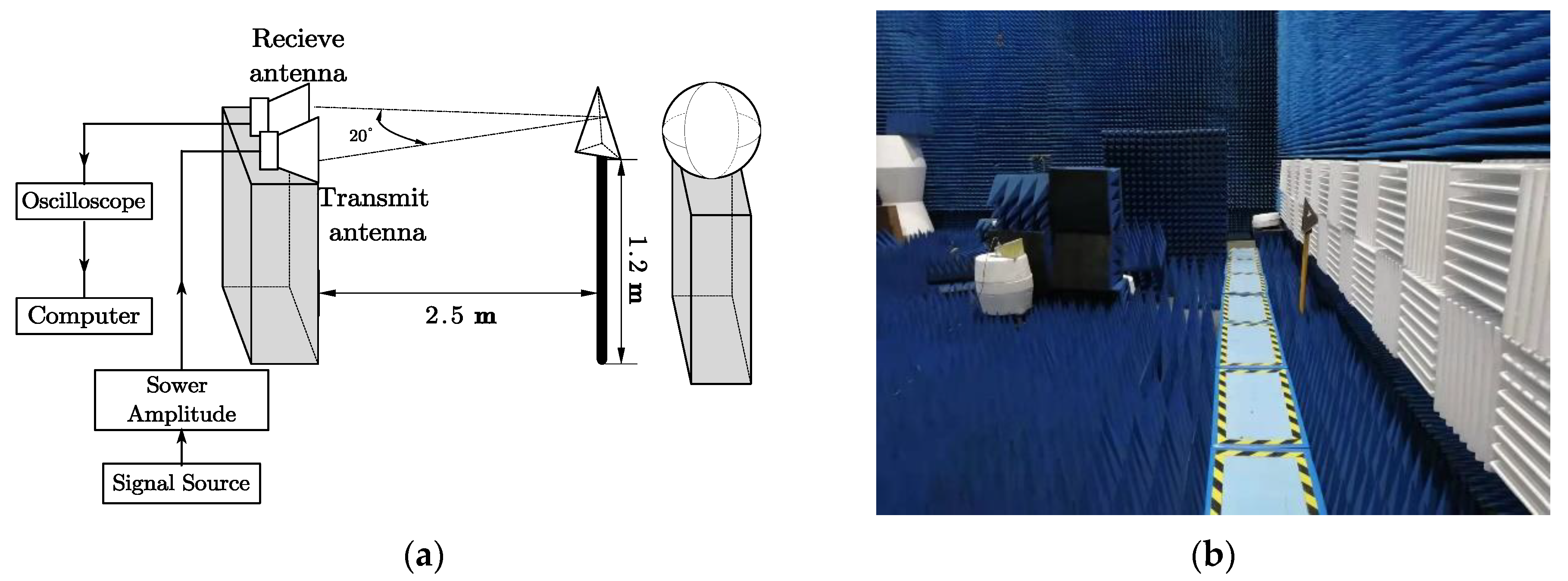


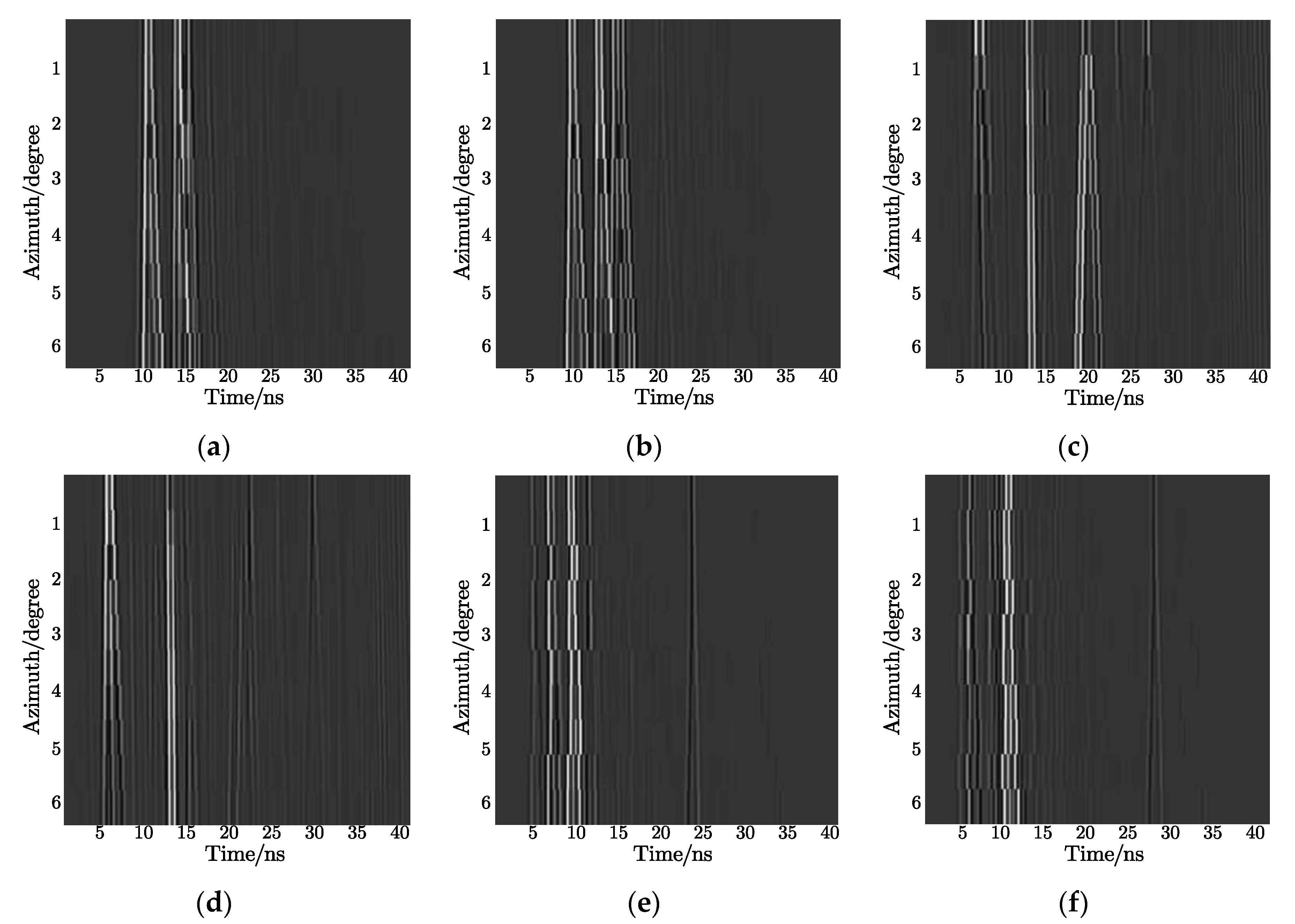




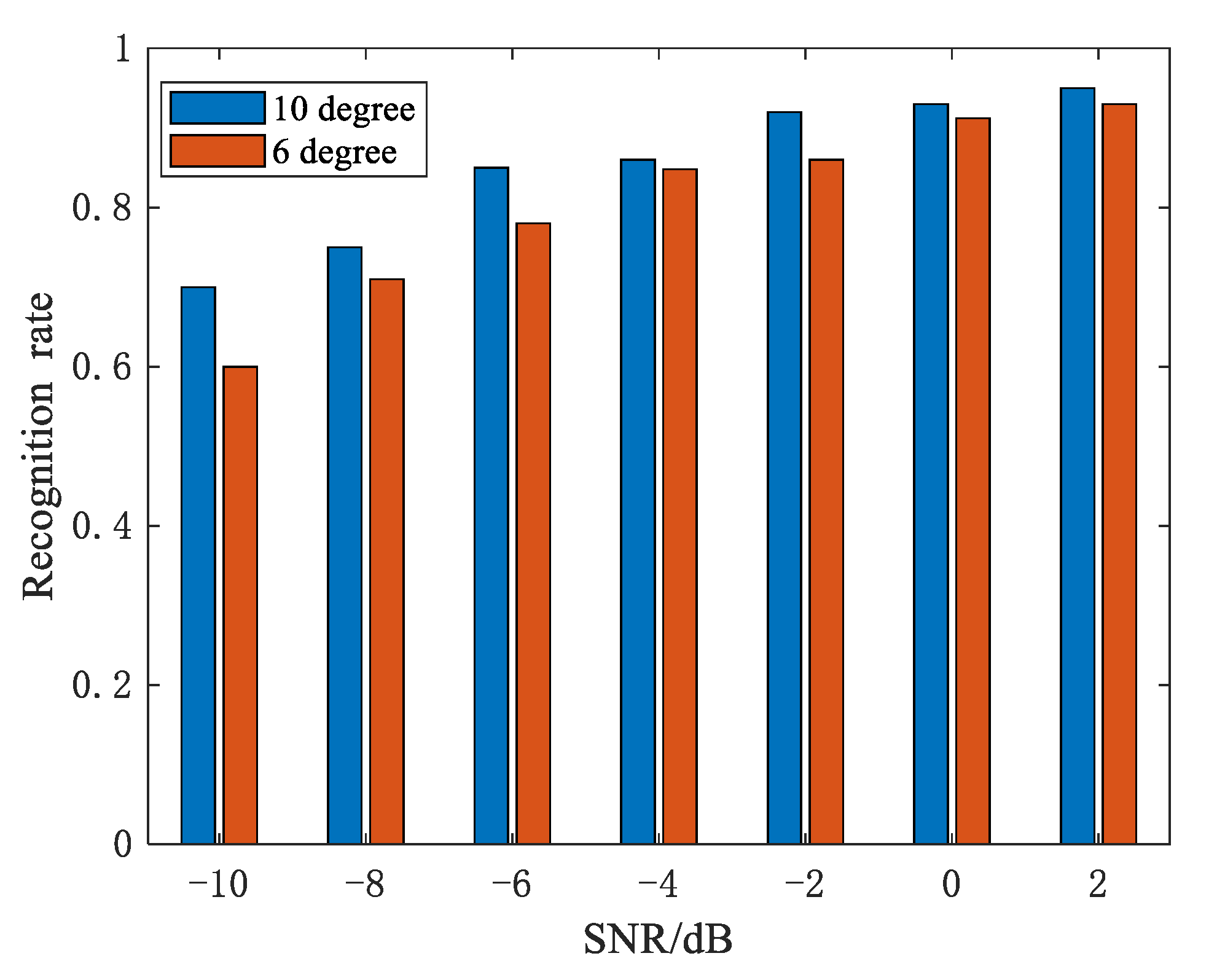
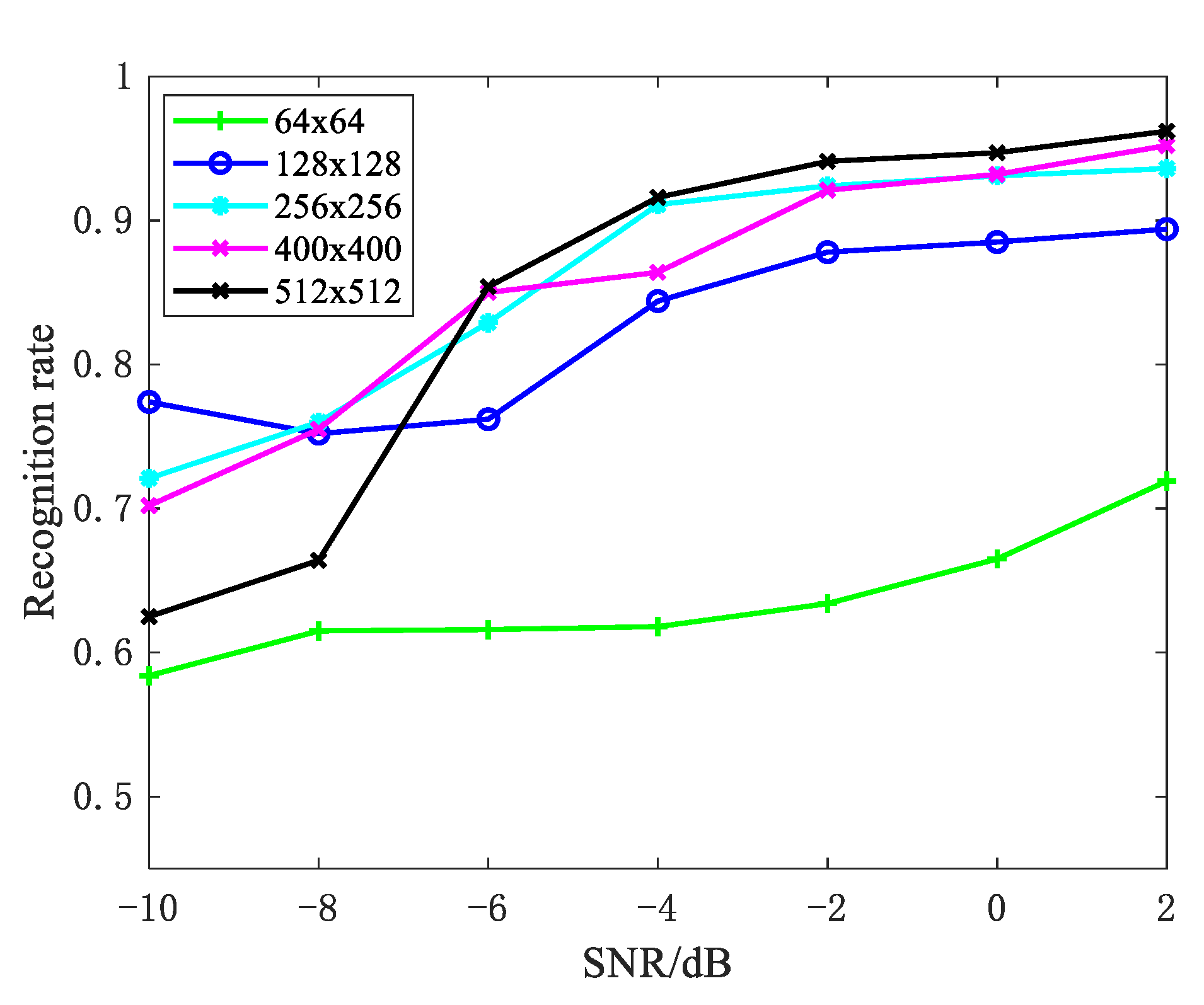
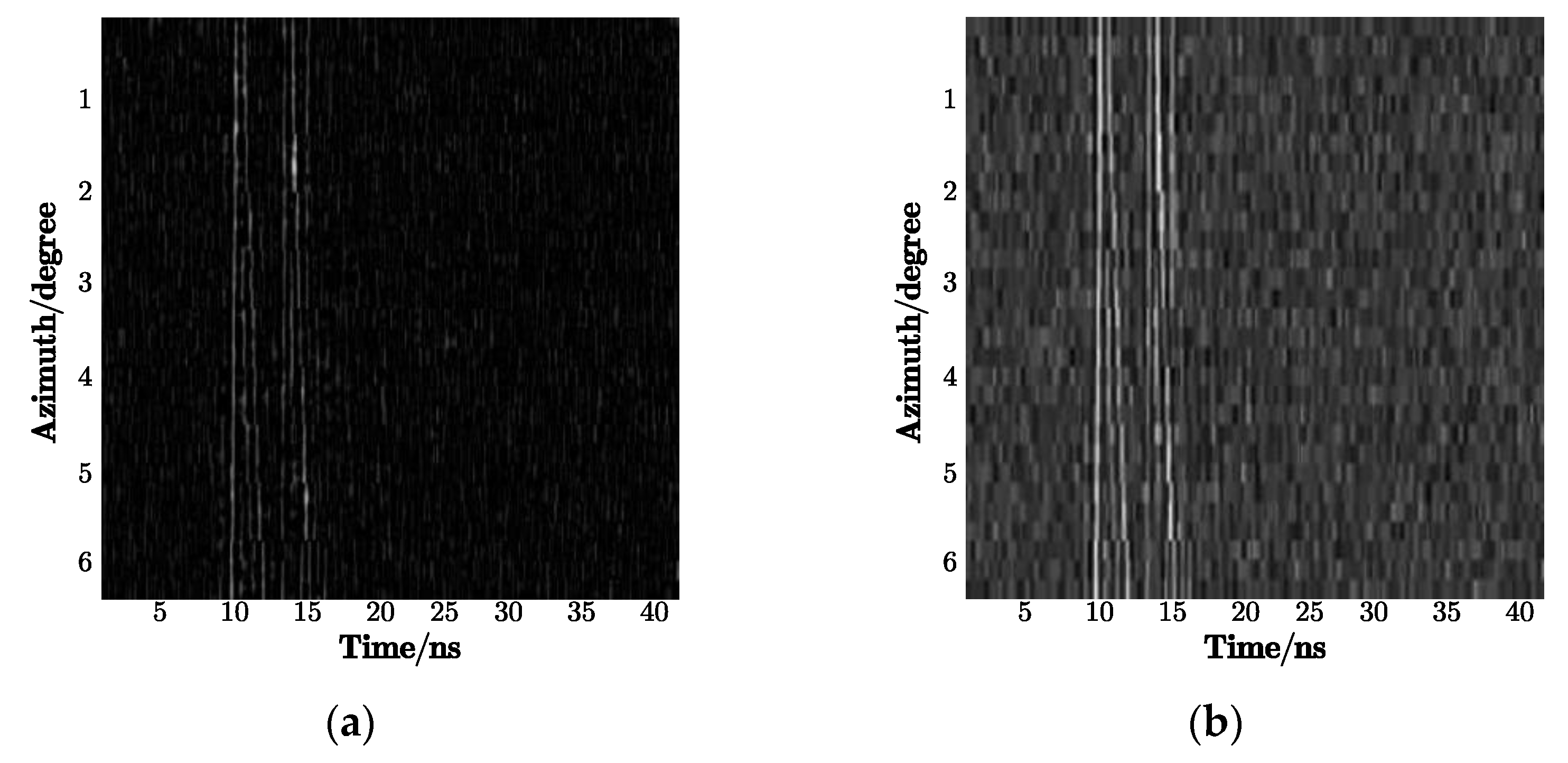
| Model Properties | CWT | EMD | VMD |
| Decomposition for nonlinear and nonstationary signals | − | + | + |
| Mode distinction | + | − | + |
| Mathematical theory | + | − | + |
| CNN | RMB | DAE | |
| Feature extraction automatic | + | − | − |
| Unsupervised learning | − | + | + |
| Translation invariance | + | − | − |
| Training efficiency | − | − | + |
| 30.83 | 28.82 | 26.86 | 26.14 | 25.36 | 23.99 | 23.97 | |
| 29.90 | 27.83 | 25.92 | 25.02 | 24.21 | 22.74 | 22.73 | |
| 28.39 | 26.63 | 25.05 | 24.17 | 23.38 | 22.14 | 21.94 | |
| 28.37 | 26.16 | 24.49 | 23.59 | 22.74 | 21.52 | 21.16 | |
| 27.94 | 25.99 | 24.15 | 23.47 | 22.46 | 21.38 | 20.84 | |
| 27.64 | 25.66 | 23.91 | 23.11 | 22.17 | 21.09 | 20.48 | |
| 27.20 | 25.31 | 23.88 | 22.78 | 21.78 | 20.75 | 20.11 | |
| 27.05 | 25.15 | 23.84 | 22.63 | 21.65 | 20.67 | 19.91 |
| Simulation Parameters | Bandwidth | 2.5 GHz | |
| Azimuth angles | 0–180° with 0.3° steps | ||
| Depression angles | 25°, 30° | ||
| Vehicles | Length (m) | Width (m) | Height (m) |
| Wheeled vehicles | 6.4 | 2.8 | 3.1 |
| Tracked vehicles | 8.3 | 3.9 | 2.4 |
| Box trucks | 7.9 | 3.5 | 3.2 |
| SVD | 0.602 | 0.562 | 0.544 | 0.535 | 0.530 | 0.525 | 0.525 |
| CS | 0.620 | 0.591 | 0.582 | 0.570 | 0.517 | 0.486 | 0.475 |
| PCA | 0.665 | 0.647 | 0.632 | 0.625 | 0.602 | 0.600 | 0.535 |
| Original data + VGG16 | 0.892 | 0.883 | 0.821 | 0.810 | 0.788 | 0.646 | 0.506 |
| 2D-EMD + VGG16 | 0.890 | 0.850 | 0.840 | 0.835 | 0.795 | 0.752 | 0.624 |
| 2D-CWT + VGG16 | 0.912 | 0.905 | 0.832 | 0.784 | 0.760 | 0.722 | 0.598 |
| SDAE | 0.928 | 0.911 | 0.895 | 0.861 | 0.848 | 0.806 | 0.719 |
| 2D-VMD + VGG16 | 0.940 | 0.924 | 0.902 | 0.853 | 0.800 | 0.662 | 0.650 |
| 2D-IVMD + VGG16 | 0.950 | 0.932 | 0.921 | 0.864 | 0.850 | 0.795 | 0.702 |
Publisher’s Note: MDPI stays neutral with regard to jurisdictional claims in published maps and institutional affiliations. |
© 2021 by the authors. Licensee MDPI, Basel, Switzerland. This article is an open access article distributed under the terms and conditions of the Creative Commons Attribution (CC BY) license (https://creativecommons.org/licenses/by/4.0/).
Share and Cite
Zhu, Y.; Zhang, S.; Zhao, H.; Chen, S. Target Identification with Improved 2D-VMD for Carrier-Free UWB Radar. Sensors 2021, 21, 2465. https://doi.org/10.3390/s21072465
Zhu Y, Zhang S, Zhao H, Chen S. Target Identification with Improved 2D-VMD for Carrier-Free UWB Radar. Sensors. 2021; 21(7):2465. https://doi.org/10.3390/s21072465
Chicago/Turabian StyleZhu, Yuying, Shuning Zhang, Huichang Zhao, and Si Chen. 2021. "Target Identification with Improved 2D-VMD for Carrier-Free UWB Radar" Sensors 21, no. 7: 2465. https://doi.org/10.3390/s21072465
APA StyleZhu, Y., Zhang, S., Zhao, H., & Chen, S. (2021). Target Identification with Improved 2D-VMD for Carrier-Free UWB Radar. Sensors, 21(7), 2465. https://doi.org/10.3390/s21072465






